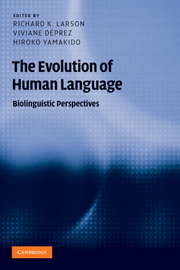Book contents
- Frontmatter
- Contents
- Figures
- Contributors
- Acknowledgments
- Introduction
- 1 The faculty of language: what is it, who has it, and how did it evolve?
- Part I Language architecture
- Part II Language and interface systems
- 6 Prospection as a cognitive precursor to symbolic communication
- 7 Did language evolve before speech?
- 8 A pragmatic perspective on the evolution of language
- Part III Biological and neurological foundations
- Part IV Anthropological context
- Notes
- References
- Index
6 - Prospection as a cognitive precursor to symbolic communication
Published online by Cambridge University Press: 05 June 2012
- Frontmatter
- Contents
- Figures
- Contributors
- Acknowledgments
- Introduction
- 1 The faculty of language: what is it, who has it, and how did it evolve?
- Part I Language architecture
- Part II Language and interface systems
- 6 Prospection as a cognitive precursor to symbolic communication
- 7 Did language evolve before speech?
- 8 A pragmatic perspective on the evolution of language
- Part III Biological and neurological foundations
- Part IV Anthropological context
- Notes
- References
- Index
Summary
What are the significant forces behind the evolution of language?
Explaining how language evolved involves answering two quite distinct scientific questions (Bickerton 2003; Tomasello 2003). The first is why humans have developed a system of symbolic representation as a basis for much of their communication. The second is why this system has acquired the structural characteristics of the syntax of extant human languages. In this paper, we focus on the first question.
Homo sapiens is the only species we know to have a symbolic language. If one believes that language has come into existence according to the principles of evolutionary theory, there should be some selective advantage that has promoted the development of language among humans. Recently, a popular approach has been that language arose as a result of increased social interaction, for example as a consequence of increasing group size (Dunbar 1996) or as some form of ritualization (Deacon 1997; Knight 1998b).
However, despite all the merits of these proposals, they have problems explaining why humanlike symbolic language has not evolved among other apes or animals (Bickerton 2002: 209; Gärdenfors 2004: 237; Johansson, Zlatev, and Gärdenfors 2006). As a matter of fact, the social interaction among many species is highly developed. Bickerton (2002: 210) argues: “When a complex and unique development occurs in only one species, the most logical conclusion is that the selective pressure driving that development must have been unique to that species.
- Type
- Chapter
- Information
- The Evolution of Human LanguageBiolinguistic Perspectives, pp. 103 - 114Publisher: Cambridge University PressPrint publication year: 2010
- 18
- Cited by



